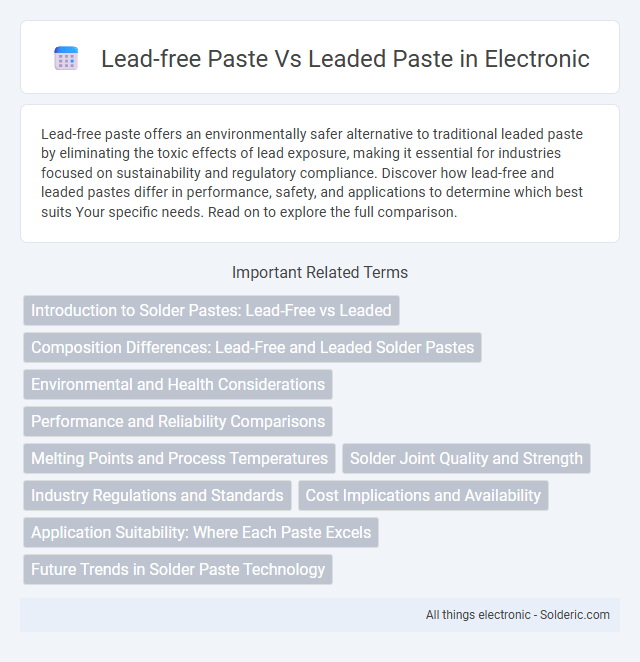Lead-free paste offers an environmentally safer alternative to traditional leaded paste by eliminating the toxic effects of lead exposure, making it essential for industries focused on sustainability and regulatory compliance. Discover how lead-free and leaded pastes differ in performance, safety, and applications to determine which best suits Your specific needs. Read on to explore the full comparison.
Comparison Table
| Feature | Lead-Free Paste | Leaded Paste |
|---|---|---|
| Toxicity | Non-toxic, environmentally friendly | Contains lead, toxic and hazardous |
| Melting Point | Higher melting point (approx. 217-227degC) | Lower melting point (approx. 183-190degC) |
| Reliability | Good thermal fatigue resistance | Excellent wetting and mechanical reliability |
| Regulatory Compliance | Meets RoHS and environmental standards | Restricted under RoHS and similar regulations |
| Cost | Typically higher cost | Generally lower cost |
| Application | Used in electronics requiring eco-friendly standards | Traditional electronics manufacturing |
Introduction to Solder Pastes: Lead-Free vs Leaded
Solder pastes are essential materials in PCB assembly that consist of metal alloy powders suspended in flux, facilitating strong electrical and mechanical connections. Lead-free pastes, primarily composed of alloys like SAC305 (Tin-Silver-Copper), offer environmental and health benefits by eliminating toxic lead content, yet they often require higher reflow temperatures. Leaded pastes, typically made with tin-lead alloys such as Sn63Pb37, provide lower melting points and superior wetting properties but pose environmental and health concerns, leading to widespread regulatory restrictions like RoHS compliance.
Composition Differences: Lead-Free and Leaded Solder Pastes
Lead-free solder paste primarily consists of a tin-based alloy, often combined with silver, copper, and other elements to enhance melting points and mechanical strength, whereas leaded solder paste contains roughly 60% tin and 40% lead, offering a lower melting point and superior wetting properties. The absence of lead in lead-free pastes makes them environmentally friendly but requires higher reflow temperatures and careful thermal profiling during soldering. Your choice between lead-free and leaded paste will impact assembly reliability, compliance with regulations like RoHS, and overall manufacturing processes.
Environmental and Health Considerations
Lead-free paste significantly reduces environmental pollution and health risks associated with lead exposure, which is a toxic heavy metal linked to neurological damage and developmental issues. Unlike leaded paste, which contains lead compounds that contaminate soil and water during disposal, lead-free alternatives use safer, non-toxic materials that comply with RoHS (Restriction of Hazardous Substances) directives. The adoption of lead-free paste supports sustainable manufacturing practices by minimizing hazardous waste and promoting safer working conditions in electronics assembly.
Performance and Reliability Comparisons
Lead-free paste typically exhibits higher melting points than leaded paste, enhancing thermal endurance and reducing the risk of joint failure in high-temperature applications. Leaded paste often provides superior wetting characteristics, resulting in stronger initial solder joints and improved electrical conductivity. Reliability tests indicate lead-free paste may experience increased susceptibility to voids and brittleness under thermal cycling, while leaded paste maintains consistent mechanical integrity over prolonged use.
Melting Points and Process Temperatures
Lead-free paste typically has a higher melting point, ranging from 217degC to 221degC, compared to leaded paste which melts around 183degC to 190degC. The increased melting temperature of lead-free solder requires higher process temperatures during PCB assembly, often exceeding 240degC to ensure proper wetting and joint formation. Your selection between lead-free and leaded paste impacts thermal profiles and may affect component reliability due to the stress of elevated soldering temperatures.
Solder Joint Quality and Strength
Lead-free paste typically produces solder joints with higher melting points, enhancing thermal resistance but potentially resulting in slightly reduced joint strength compared to leaded paste. Leaded paste offers superior wetting properties, creating more reliable and robust solder joints with improved mechanical strength, essential for vibration-prone environments. Choosing the right solder paste impacts your electronic assembly's durability and performance, balancing environmental compliance and joint integrity.
Industry Regulations and Standards
Industry regulations such as RoHS (Restriction of Hazardous Substances) mandate the use of lead-free paste in electronics manufacturing to reduce environmental and health risks. Lead-free paste complies with stricter standards, ensuring your products meet global safety and sustainability requirements. In contrast, leaded paste, though effective in certain applications, faces increasing restrictions due to its toxic lead content.
Cost Implications and Availability
Lead-free paste generally incurs higher costs due to more expensive raw materials and stricter environmental regulations impacting production and supply chains. Leaded paste remains more widely available and cost-effective, benefiting from established manufacturing processes and sourcing of lead-containing compounds. Your choice between lead-free and leaded paste significantly affects budget planning and material accessibility in electronics manufacturing.
Application Suitability: Where Each Paste Excels
Lead-free paste excels in applications requiring environmental compliance and high-temperature resistance, such as consumer electronics and automotive industries adhering to RoHS standards. Leaded paste is preferred in high-reliability sectors like aerospace and military electronics due to its lower melting point and superior wetting properties, which facilitate easier soldering on complex components. Your choice depends on specific application needs, balancing environmental regulations and performance requirements.
Future Trends in Solder Paste Technology
Future trends in solder paste technology emphasize the growing adoption of lead-free paste to meet environmental regulations such as RoHS and REACH, driving innovation in alloy compositions like SAC305 to enhance thermal reliability and mechanical strength. Advances in flux formulations are improving wetting performance and reducing void formation, while nano-silver and bio-based fluxes are emerging to address sustainability and performance demands. Industry research is increasingly focused on reducing solder joint defects and improving process window robustness, ensuring higher yield and reliability in lead-free solder paste applications.
Lead-free paste vs leaded paste Infographic

 solderic.com
solderic.com